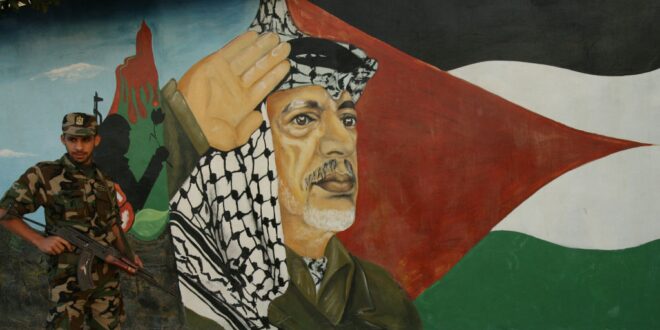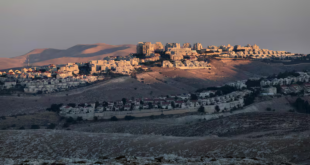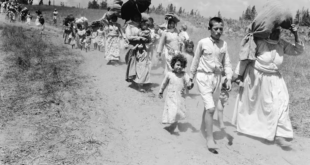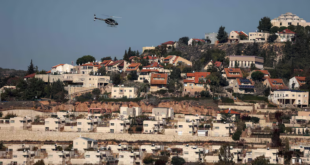Ramallah is a dusty city built, you soon realise, around a fort. This is the Mukataa, or the “headquarters”, separated from the streets by walls and watchtowers. Mandate officials, Jordanian officers and the IDF have all been based here — running prisons, courts and successive occupations.
Today, it is the sealed-off seat of the Palestinian Authority, and the only part you can see from the road is a mausoleum. Cubic, like the Kaaba in Mecca but in Jerusalem stone, this is Yasser Arafat’s tomb. Framed by glass, water and an honour guard, it is unremarkable for a Middle Eastern leader. Apart from one thing: the constant reminders, from the signs or guides, that this mausoleum is temporary. The entire edifice, facing Jerusalem, is built on train tracks, a symbolic reference to what is hoped will be Palestine’s eventual liberation and Arafat’s reburial on the holy mount.
This mausoleum was opened in 2007 by his successor Mahmoud Abbas, the second President of his half-state, the Palestinian Authority, and the fourth secretary of his movement, the Palestinian Liberation Organisation. Solemn, even surly, Abbas swore to the crowds that day that “we will continue the path of the martyred President Yasser Arafat to be reburied in Jerusalem, which he loved…”
But despite the commonality of their aims, the contrast between how the two ran the Mukataa could not be greater. Arafat withered away in his besieged basement bunker between cans of gasoline and AK-47s, his intifada in ruins. Abbas, in his political twilight, uses it to greet a non-stop delegation of diplomats and NGOs. His Ramallah is uneasy, but MacBooks still open in its cafés, while Gaza is in ruins. Such disparity speaks to the biggest question in Palestinian politics. Is the way forward, as Arafat finally decided, one of violence — or that of Abbas, one of negotiation?
Initially, they had offered the same answer. When Abbas, a refugee from Galilee, first met Arafat in Qatar in 1961, the two were of one mind about revolutionary struggle: neither relying on Arab patrons nor swallowing their ideologies, the Palestinians themselves had to become the main force of their liberation. The museum in the Mukataa documents what happened next. Fatah, their party, entered the refugee camps, slowly at first, then rapidly as posters announced the resistance’s arrival. Despite the huge Arab defeats of 1967 and 1973, a myth emerged: that out of shame came honour, thanks to the PLO campaign, forcing Israel to accept it had to negotiate with the Palestinians themselves.
In 2000, as President Clinton fretted about his legacy and convened the fateful Camp David summit between the parties, it seemed to Western diplomats as if Arafat and Abbas had almost won. Exiled to Tunis, after Ariel Sharon expelled the PLO from Lebanon, the legitimacy they had gathered and the revolt they had inspired in the First Intifada meant Israel had not only negotiated with them, but brought them back to run Gaza and the main towns of the West Bank. Arafat had triumphed in rebellion; Abbas, the architect of the secret talks and the Oslo Process, in negotiation. All they needed to do was sign on the dotted line.
But this was not how it looked to many Palestinian intellectuals, who feared the PLO had fallen into a trap. In New York, Edward Said denounced the Oslo Accords as “an instrument of Arab surrender”. In the territories themselves, the corruption and oppression the Mukataa was seen to personify meant Arafat was increasingly seen as a dictator rather than a defender. The Islamist Hamas started to gain on the nationalist Fatah, launching its own terror campaign to derail the peace process. Unrest stirred.
Recollections differ about what happened at Camp David. Israeli and American diplomats believe they presented a generous final offer to the Palestinian team, which Arafat vetoed, instead resorting to violence from the Mukataa. Palestinian negotiators such as Ghaif al-Omari claim that nothing approaching final terms were presented, with Arafat undecided and his team fissured between old and young. In this telling, Abbas and Ahmed Querei, the elders, became intransigent, suspicious that the juniors, such as Mohammed Dahlan, were trying to seal a deal and take the credit.
What is clear, however, is that in that moment of compromise, Arafat became obsessed with Jerusalem, insisting that Israel had no rights to the holy mount, as King Solomon’s Temple was in Nablus. He rejected Clinton’s essential proposal: that everything above ground (both Al-Aqsa and the Dome of the Rock) would be Palestinian, while everything below ground and the Wailing Wall would be Israeli.
His motivation is a matter of speculation. Was it the four years that Arafat spent in the Old City, living in the Israeli-bulldozed medieval warren of the Murghabi district under the golden glint of the Haram al-Sharif? Or a sense that, if he failed to liberate the third holiest site in Islam, he would always be viewed as a compromiser and not Saladin? Or, as Saeb Erekat, a Palestinian politician and negotiator at Camp David, believed, was it a moral claim — that Arafat simply could not accept Israel had any right to it?
The truth is that, whatever thoughts there were beneath his keffiyeh, there was nothing remarkable about Arafat’s refusal to compromise. So central is the Temple Mount to Judaism that it is often overlooked how important what they call the Haram al-Sharif is for Palestinians, a people whose very essence of nationhood is bound to the idea of being the defenders of Al-Aqsa. But this intransigence shocked and infuriated the US President. “You are leading your people and the region to catastrophe,” a frustrated Clinton is said to have exclaimed.
Camp David failed in July. That autumn, protesting Israeli Prime Minister Barak’s willingness to trade it for peace, Arafat’s old enemy Ariel Sharon chose to visit what he called the Temple Mount. Rioting erupted. And very soon it was apparent these were more than days of rage. Even now, Palestinian officials remain divided about how the intifada truly exploded. One side stresses that Arafat was being overtaken by events — the visit of Sharon, the sudden riots, spontaneous lynching — and decided to go along with it, thinking a bit of violence would mean better terms, while others see him as more forcefully encouraging it once it began.
The reality, however, hardly mattered, given Arafat would soon decide to fight the intifada from the Mukataa. Instead of forcing a return to the negotiating table, his soldiers, such as Marwan Barghouti’s Tanzim and the Al-Aqsa Martyr’s Brigade, were soon launching suicide bombings inside Israel. First quietly then loudly, Abbas opposed this — viewing the war as a disaster for Palestine.
Dying in his bunker, Arafat was consumed with the idea that King Solomon’s Kingdom was never in Palestine, but in Yemen. By 2003, it was obvious he had dug his political tomb. Yet few recognised he had also buried the Palestinian state for a generation, trapping the West Bank in the kind of “joint-rule” hawkish Israeli strategists always wanted. Nor was it clear that, by personifying the Palestinian resistance, only Arafat could have made peace.
You do not have to visit the walls of the Mukataa to realise that Abbas is the inheritor of Arafat’s tomb. That Abbas, the man who heroically denounced violence amid the disaster of the intifada and worked to end it with Israel and the United States, has not been able to escape his legacy. This applies both to Palestine’s territory and its expansion. After all, Abbas is unable to agree a new proposal, because he knows that, unlike Arafat, he has had no legitimacy to sign one. Those by his side in 2005 remember a man overwhelmed, bunkering down.
And yet, there is a strand of continuity in the politics of Abbas, stretching back to the heady days of the PLO in Lebanon. From the mid-Seventies, Palestinian politics were divided between rationalists, who saw the future involving some kind of accommodation with Israel, and radicals, who would accept none. Arafat flitted and played with the two. But Abbas was squarely rationalist.
This remains true to this day. Rationally, he knows he never had the power to lead a successful intifada against Israel. Rationally, he knows he has never had the legitimacy to sign a peace accord, whose compromises vast swathes of the nation would see as a betrayal. And rationally, ever since he lost Gaza to Hamas in 2007, he has decided that the best course of action is to simply hold on.
This logic has turned the Mukataa from what was once a symbol of revolution into a symbol of an authoritarian Arab regime in miniature: a system tied together by corruption, where no elections have been held since 2005. Fatah, in turn, is now widely derided as an empty card-carrying shell — like the Ba’ath party in Syria or the old Eastern bloc. Across the West Bank, the system is largely outright despised.
Abbas, in his twilight, has never been weaker but also never more central. At night in Ramallah, there are protests, but things are still quiet. At night in Gaza, there is the thunder of bombs. Never in Palestinian history has the contrast between violence and negotiation been so stark. No longer between Abbas and Arafat, the contrast is between the Palestinian Authority and Hamas. This appears hard to see from a distance, but October 7 was the start of a new war for Jerusalem, launched “in defence of the Al-Aqsa mosque”. Named “Operation Al Aqsa Floods”, Hamas’s massacre was only the latest offensive in what they see as an unending one, to stop the Jews “erecting their alleged temple on the ruins of the shrine of our Prophet Mohammed”.
Hamas sought, on October 7, not only to start a war with Israel but to detonate the West Bank. Their leaders dreamed that with mass hostage-taking they could bring Israeli society to its knees and force the release of all Palestinian prisoners — grabbing in one jubilant swoop the ownership of the Palestinian cause from the PLO. Opinion is divided among Palestinian analysts over their successes. All agree Hamas’s popularity is soaring in the West Bank, with crowds chanting its slogans even in the heart of Ramallah. But opinions differ over whether or not tensions in the West Bank actually threaten the Mukataa.
Abbas’s response has mostly been silent. Rationally, he believes the best strategy is to avoid tempting a possible intifada or Israeli action against him. But behind this muted response to the bloodshed, the Mukataa believe that Hamas has led the Palestinian people — with the destruction of Gaza City and now Khan Younis — into the greatest disaster of their history since 1948. Massacres are not new to the land, but never before has a city been levelled in the entire conflict. “Hamas entered a battle and the result was the complete destruction of Gaza. To blindly follow slogans to satisfy an illusion and the result is the destruction of the Palestinian people.” These were the words of Abbas a decade ago, but they could have been said yesterday. “I am responsible for the people and I will not allow their destruction to happen again.”
This is the crux of Palestinian politics. Hamas believes only violence can force the liberation of Al-Aqsa. Abbas believes only negotiations and the international community can. Hamas sees him as a corrupt collaborator. Abbas sees himself as protecting his people from what Gazans call the Israeli “monster” and guarding the mechanism that will eventually deliver a Palestinian state. Meanwhile, Western and Arab diplomats have come to see him as an intransigent obstacle to any progress towards a “two-state solution”. The tragedy, however, is that with the Palestinian people now so divided, the only man who could have made peace on behalf of all of them is buried in the Mukataa.
 Eurasia Press & News
Eurasia Press & News



